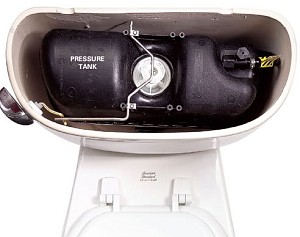Pressure-Assist Toilets: Benefits and Costs

Photo credit: Reader's Digest
What’s Inside a Pressure-Assist Toilet?
Essentially, there are two main kinds of toilets: gravity-flow and pressure-assist. It is important to familiarize the inside of either toilet so when clogging issues arise, you’ll know where to look in the same manner as knowing how to unblock a u-bend sink when needed. Most common is the gravity-flow toilet, a basic type of toilet that contains water inside the toilet tank. A pressure-assist toilet is different from a gravity-flow toilet in one department – the inside of the toilet tank.
When you peer inside a gravity-flow toilet tank, water is the main component. If one were to open up a pressure-assist toilet tank, an additional, smaller tank would be visible. Pressure-assisted toilets have a tank inside of another tank so that a large amount of air pressure is created in between the two tanks. This pressure makes it possible for more water to stay inside the toilet bowl, which, in turn, results in a cleaner toilet.
Cons of a Pressure-Assist Toilet
- Noise. Pressure-assist toilets are popular within industrial settings, since they are far more efficient than gravity-flow toilets. However, most homeowners do not purchase pressure-assist toilets since these toilets tend to be rather loud.
- Availability of parts. The inner workings of a pressure-assist toilet are not the same as a gravity-flow toilet. Because most hardware stores don’t stock these parts regularly, replacing or repairing parts components of a pressurized toilet is somewhat difficult and could result in a bad plumbing situation if not done correctly.
- Price. Pressure-assist toilets are more expensive than regular gravity-flow toilets. While a standard gravity-flow toilet can be purchased for around $120 to $300, a pressure-assist toilet may cost as much as $700.
- Difficulty of flushing. The flush lever on a pressure-assist toilet must be pushed with more force than a gravity-flow fixture. This may make it difficult for a young child or a strength-impaired adult to operate.
Pros of a Pressure-Assist Toilet
Even though there are some drawbacks to a pressure-assisted toilet, there are also several benefits to consider.
- Efficiency. Pressure-assist toilets are much more efficient, thanks to their forceful flush. There is hardly ever a need to flush twice and toilet clogs are rare, even in aging plumbing pipes.
- Water savings. These toilets help you save water. Each flush of pressure-assist toilet uses 1.1-1.2 gallons, compared to dual-flush gravity-flow at 1.3 gallons or single-flow (1.6). That can add up to 4,000 gallons annually.
- Lower maintenance. A pressure-assist toilet contains fewer moving parts, meaning it will be less likely to break down and require servicing. This is not to say that a pressure-assisted toilet is free of all problems, especially if you reside in an area prone to freezing temperatures (check out our article about freezing pipes solutions to prepare your plumbing for winter months).
- No condensation. Lastly, many homeowners and business owners choose pressure-assisted toilets because these toilets are not impacted by humid weather (readers in Miami know what I'm talking about). That’s because the tank-in-tank design reduces any amount of sweat.
By weighing the pros and cons of a gravity-flow toilet versus a pressure-assisted toilet, you can determine the right kind of toilet for your home. Then all you have to do is find a reliable plumber near you to install it for you.
Updated June 22 2021.
Looking for a Pro? Call us (866) 441-6648

Plumbing Average Costs
Plumbers Experiences

Replacement Water Heater For Our Condo At The Lake

Clearing A Bathtub Drain Makes It Run Smoother Than Ever



